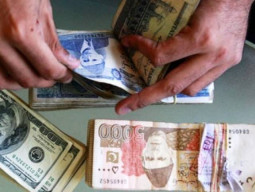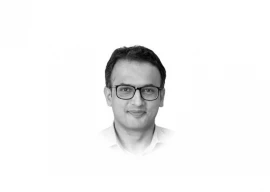
Water, water everywhere and not a drop to drink. That’s certainly a thought that comes to mind traversing one of Islamabad, Lahore or Karachi’s brand new roads. Roads, roads everywhere but no relief from the congestion.
There have been voices of discontent over the many avenues laid through the middle of Islamabad. Although there are Seventh and Agha Shahi Avenues, traffic remains unruly. In Lahore, a decade of spending billions on Jail, Ferozepur and Canal roads hasn’t improved traffic. And Lahore, Karachi and Islamabad are the Jewels of the Crown: the traffic in other cities — Rawalpindi, Peshawar, Faisalabad, Sukkur — shakes the foundations of one’s belief. What should raise eyebrows is the fact that if the strategy to solve traffic congestion employed in large cities — throwing infrastructure, the odd bridge and underpass, at the problem — hasn’t worked so far, how will it work in our other cities? Will they be bound to the same trajectory into the dusty and dangerous cement-scapes these big cities are becoming or have already become?
There are two fundamental considerations that urban planning experts must make when devising urban transport policies. The first is it that mobility is the basic fundamental right of every citizen. She or he should be free to traverse across cities unhindered and unmolested. By not providing adequate provision for safe walking and cycling and respectful public transport, urban planners are violating this right by depriving citizens of the ability to choose their means of transport.
The point becomes more clear when one reflects on the actual position of urban mobility. In Lahore, about eight per cent of the population has access to a private automobile. A recent report indicates that nearly 20 per cent of the city gets to work by bus and 40 per cent gets about by foot. The report also highlights that Lahoris take an estimated 9.8 million trips a day. For a city of nearly 10 million, this figure is less than half of other cities of comparable size. In effect, women, children, senior citizens and the handicapped are rendered immobile by the lack of mobility options.
Why, then, lay down road infrastructure for the use of private automobiles without providing for the overwhelming number of public transport users and pedestrians? This is why Enrique Penalosa, former mayor of the Colombian city of Bogota and the architect of that city’s transport-based urban transformation, says that democracy is demonstrated as much by how a city uses its roads as an election. A city which provides more for the few is not a democratic place. A society that treats a man on a cycle differently from a man in a car is not democratic.
Lahore’s streets are currently in the process of being ripped apart and rebuilt for the much vaunted Bus Rapid Transit system (BRT). The BRT plan follows, with some deviation, the route for a mass transit system proposed during the Pervaiz Elahi government. While mass transit systems are meant to make the city more sustainable and user-friendly, there has been criticism of the apparent lack of planning and last-minute changes to the BRT route. Also, despite warnings raised by NGOs during it’s Environment Impact Assessment hearing, the dust levels created by the construction work have moved the Environment Protection Agency, Punjab to take action — something the government-friendly EPA doesn’t normally do.
The Lahore BRT is an ambitious and costly project which raises the risk that if not properly executed, it could end public transport initiatives in other cities. Hence, the second fundamental consideration urban planners must make is that, according to research, building new roads increases demand for cars and that public transport alone does nothing to solve traffic congestion.
The Braess Paradox of urban congestion stipulates that if you build it, the cars will come. In our context, the experience of building new roads in Islamabad, Karachi and Lahore, without real change in levels of traffic, proves the point. And the findings of US researchers in their paper, “The Fundamental Law of Road Congestion”, indicate that road-widening and public transport will not make a dent against traffic. Instead, they indicate that the latest techniques of congestion charging may be a possible solution.
The question is whether our urban planners are open to new ideas. The answer must be yes. The current strategy of road congestion isn’t working and our cities and the productivity of their people stand compromised. I remain sceptical. The Lahore Parking Company — the entity that would most likely be responsible for devising parking policies — recently placed an advertisement for the position of a “General Manger Operations”! Happy cow indeed.
Published in The Express Tribune, July 19th, 2012.
COMMENTS (12)
Comments are moderated and generally will be posted if they are on-topic and not abusive.
For more information, please see our Comments FAQ














































Dear Author When you build new roads and these new roads again become congested again, all is not lost. What you have achieved is economic growth which should be a prime objective of any govt. If all you want is empty roads may be we should just have the political parties call in a strike.
@Aliya & Fahad, get u r facts right, Pervaiz Elahi Mass Transit system (Underground / Elevated) cost was around $ 2.4 Billion (260 Billion Pak Rs). Monorail is cheaper then Underground / Elevated Train system but still cost around $ 1.2 Billion (130 Billion Pak Rs).
Kuala Lumpur Monorail 8.53 KM and costs $311 Million (Per KM cost is $ 36.45 Million). 32 KM Mono Rail in Lahore would cost around $ 1.2 Billion.
Bus Rapid Transit is only viable solution with 20-25 Billion Pak Rupee you can get dedicated transport for public with signal free end to end access.
It's not just the urban planner that need to reconsider but mainly the politicians. They prefer to build roads and bridges so they can eat public funds. The fact that Pervaz Elahi Mass Transit was scrapped just for political gains shows how petty the political mind set is. CM Punjab is running a one man show and these are the results
I fail to understand why every Mass Transit solution in this country revolves around a BUS! The world has moved to elevated mono-rails and subways and we are still looking at Buses as the ultimate solution. While Buses are quick cheap solution, that is all they are...it is not a long term MASS TRANSIT solution. Take up the example of Dubai that has just year or so back started its elevated train network. Its been a whopping success, infact revenues from it surpassed all projections. Yes, its costly and time consuming...but long term solution are costly and time consuming. Just like 10 mini-dams wont replace the need for a Kalabagh Dam, a hundred busses wont solve the need for MASS TRANSIT. I wish these politicos would think beyond their 5 year election tenors when planning solutions
To all my pakistani friends I live in ahmedabad,gujarat. My city has BRT system we call it BRTS though. but this system is one of the best in india and has got so many international awards for the city. It is working fine and giving much needed space to city municipal bus which doesn't run on BRT tracts.BRT is said to be costly but it is much cheaper than Metro system.And it can be build in lesser time. I am sure your people will come and take a look at this system because it is simply best in whole south asia.
I agree with the writer and being a highway engineer myself, I must emphasize that adding roads, flyovers, underpasses, additional lanes / carriageways cannot solve the congestion problem. The most crucial aspect of this engineering problem is very much social at its core. The vehicle number on our roads if far less than the west and in comparison we have a well developed infrastructure however what we need is road sense and a disciplined considerate road user. Just by eradicating corruption from our driving license issuing authorities and adopting & implementing traffic laws in true letter and spirit will substantially ease up the congestion problem. Projects like BRT will not work considering how we behave on our roads.
MRT is the only way to handle large scale daily migration. It is a tried and tested solution. BUT the applied solution has to be indigenous. Developed and perfected by simulations and small scale prototypes. No point looking to the west even if it is Turkey in this case. My fear is that we are making an elevated motorway for motorcycles not MRT in its true spirit and purpose.
I think we should wait and see how it comes out. Of course, the project will cause pollution to a certain level during construction. We can't continue expanding roads and building underpasses, they are all temporary solutions. The only permanent solution, in my humble opinion, is to provide an efficient and cheap public transport system which makes this BRTS so ambitious.
@Inam Shah: Since when have "Enviornmental impacts" become temporary? The link between infrastructure and development is based on appropriate infrastructure. Not "lets pave everything and made a road, here, there and everywhere"! If build baby, build! was indeed the case, China wouldnt be spending $100 of billions on trying to turn back the clock on all the poor planning and poor urban design of the past 30 years, as environmental damages costs soar! And please do explain how being stuck in traffic is going to lead to Economic development? If your workers in your factory cant get to work on time how does that help Economic growth?
That is a 'populace' piece of writing; raising voice for pedestrians and cyclist is pleasing to senses; however, depicts an elementary knowledge of the writer. He totally evaded the massive economic benefits of the mentioned development. Infrastructure is directly proportional to economic development. Environmental impacts and inconveniences are temporary; its fruits would be ripen by generations to come.
Agreed. Traffic should not be controlled by just building new infrastructure but devising techniques for better traffic control operations which require cooperation of public. The process requires patience something which is not inherent in our DNA.
We are a self serving populace. Our middle classes demand roads to drive their new cars and motorcycles, as for them, that is what they consider progress. A government that pumps money into public transport will hardly garner support from the well off, who will consider it below their stature to take a bus or use public transport and then shout that "hakumat hamarai liyai kuch nahi karti"